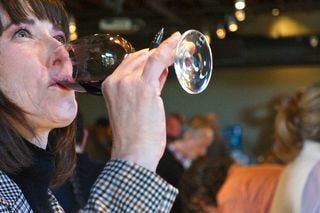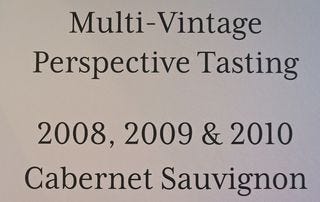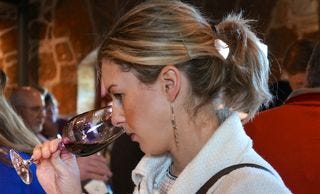Napa Valley – How I Do Love Thee!

The only way you can make living in Napa Valley any better is to stage a weekend wine event, invite a thousand professional wine tasters, and let them loose, tasting hundreds of unreleased wines.
It’s a bit like inviting lemmings to a cliff. They all come. They all partake. They all jump.

This weekend marks one of my favorite annual wine events in the valley, the mid-winter Premiere Barrel Auction, organized by the highly professional trade group called Napa Valley Vintners (NVV), a marketing association representing 450 local wineries.
This morning’s session, organized by NVV, called a Multi-Vintage Perspective, gave professional tasters and tradespeople a chance to taste three successive vintages of Chardonnay and three of Cabernet Sauvignon, to prove that climate and weather DO make a difference in winemaking here.
The tasting was held at the Rudd Center for Professional Wine Studies at the Culinary Institute of America’s St. Helena campus.
British wine expert, Steven Spurrier
Among attendees were Steven Spurrier, the UK wine expert who organized the famous 1976 Paris Wine Tasting, and Napa Valley’s own Karen MacNeil, author of “The Wine Bible“ (which is a MUST compendium in every wine library).
Karen MacNeil and Steven Spurrier
The session enabled invitees to taste blind three vintages of Chardonnay (the ‘09, ‘10, & ‘11 vintages) from 12 different producers and three vintages of Cabernet (the ’08, ’09 & ’10 vintages) from 12 different producers. A total of 72 wines tasted blind.
Tasters tasted.... photographers photographed...
This is often one of my favorite tastings because it reaffirms my belief that when Napa Valley Cabernets are tasted blind, price does not necessarily dictate quality.
Often at this tasting, my preferred wines are the low- to mid-priced wines, not the really expensive, cult wines.
A roomful of tasters
This year, for example, I rated the 2010 Reynolds Family Estate Cabernet Sauvignon and the 2009 Titus Cabernet Sauvignon as my top wines of the blind tasting.
The 2010 Reynolds Family Estate Cab is a gorgeous, beautifully balanced wine, showing a great deal of elegance and “European restraint,” as Steve Spurrier noted. It retails for $45 (they haven’t raised their price in 10 years, according to Matt in their tasting room).
This 2010 wine won’t be available in retail circles until May, 2014 ... but oh! is it worth waiting for!
The 2009 Titus Family Estate Reserve Cab had me going back for seconds and thirds. I loved the structure, the complexity, the texture and balance of this wine. Simply breathtaking. It retails for $65.
By contrast, there were wines in the tasting running from $110 to $230 a bottle, which I didn’t think showed as well.
Emma Wellings, UK taster
The purpose of this tasting was to show that our wines DO alter from year to year; many consumers think that we have hot, sunny summers every year, but, in truth, no two vintages here are the same.
The wine buyer for Selfridges, London, was on hand to judge Napa Valley wines. She took notes on her Samsung tablet, converting hand-written notes to typewritten text at the stroke of a button.
2008
This was a nightmarish vintage born with a crippling spring frost, which lowered yields, followed by dry-bordering-on-drought conditions, followed by freaky summer heat spikes. You want an example of an inconsistent vintage? This is it.
2009
The trick this year was to pick before the rains came in mid-October or to wait to pick until well afterward. Anyone who picked during the deluge, has watered-down wine. The 2009s are, for the most part, lovely, medium-weight, graceful wines, built for a long evolution.
2010
Until I tasted the 2012s (which readers won’t see for some time), I thought that 2010s were among the best we’ve ever made in Napa Valley. The killer Cabs are powerful, shockingly big, yet balanced - what wine writers like to call a “thrilling vintage.”


